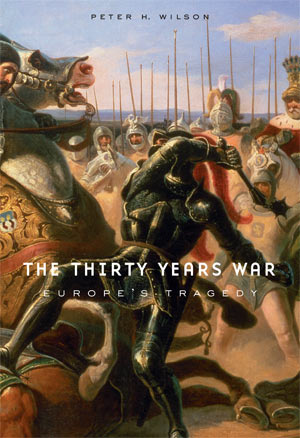
The Thirty Years War (1618-1648) was the most destructive conflict in European history prior to the twentieth-century world wars. The War was a struggle over the political and religious order in the Holy Roman Empire, Europe’s second largest state (after Russia, which was then generally not considered part of Europe). The Empire encompassed modern Germany, Austria, Czech Republic, parts of Denmark, France and Poland, and also held jurisdiction over northern Italy.
Around 1.8 million soldiers and at least 3.2 million civilians died in the Thirty Years War, reducing the Empire’s population by at least a fifth. This represents, proportionally, a far higher loss than that suffered in either world war.
The conflict left a deep imprint on European consciousness. It was ranked ahead of the Nazi era and the Black Death by late twentieth-century Germans as their country’s greatest disaster. Seminal works of German literature—notably Friedrich Schiller’s trilogy about the imperial general Wallenstein, and Grimmelshausen’s Simplicius Simplicissimus, the first German novel which later formed the basis for Bertolt Brecht’s play, Mother Courage—enduringly placed the Thirty Years War in the popular imagination. Only now, with the proliferation of modern media images of more recent carnage, the memory of the Thirty Years War is fading.
My book is the first full-length treatment of the conflict to appear for seventy years. And it is also the first treatment to give equal coverage to the War’s second half. My interpretation differs substantially from previous accounts which tend to see the War as inevitable.
The real tragedy of the conflict is that it could have been avoided, or at least shortened or contained. That does not mean that the fighting ever was “meaningless” as depicted by C.V. Wedgwood in her justly famous study first published in 1938. Real issues were at stake throughout. It was the intractability of these issues, combined with the self-interest of all protagonists, which frustrated peace making for thirty years.
“The Holy Roman Empire enjoyed 63 years of internal peace between 1555 and 1618—an era of tranquility in German history only matched in 2008 by the continuous peace since 1945.”
It was not my intention to diverge so sharply from the accepted interpretation of the Thirty Years War. My brief was to write an accessible account, updated to incorporate insights from more recent research and to consider questions which have only recently assumed importance in historical scholarship.
But having wrestled with the subject for nearly seven years, I can readily understand the temptation to fit the War into grand, generalized interpretations. One of the most persistent and apparently persuasive of these is the belief that the War was a religious conflict with its roots in the Protestant Reformation of the early sixteenth century.
The Reformation shattered the medieval unity of religion and law. People nonetheless clung to the belief that truth and justice were singular, not plural, thereby denying dissenters any legitimacy. These tensions were allegedly only papered over in the Empire by the Peace of Augsburg in 1555 which allowed most German princes to choose between Lutheranism and Catholicism according to the famous principle, “he who rules, decides the religion” (a phrase that isn’t in fact in the peace, but comes from a much later commentary on it). Religious identities hardened as the generation born after the Reformation reached adulthood and influence. The Empire supposedly polarized into two armed camps around the Protestant Union (1608) and the Catholic League (1609). General war followed the Defenestration of Prague when some Bohemian aristocrats threw two of the emperor’s representatives and their secretary out of the palace window in May 1618. (All three survived, by the way, and the secretary, who is usually forgotten, was ennobled as “von Hohenfall,” or “of the high fall.”)
Unfortunately, this simple explanation does not hold up. The Holy Roman Empire enjoyed 63 years of internal peace between 1555 and 1618—an era of tranquility in German history only matched in 2008 by the continuous peace since 1945. France and the Netherlands descended into violent civil wars from the 1560s, but Germans preferred to argue rather than fight over their constitutional order. There were even signs that tensions were ebbing by 1618: the League had been disbanded while the Union was in a state of near collapse. Neither organization encompassed all their co-religionists, while the majority in the Empire hoped negotiation would resolve differences.
The War resulted from contingency and human error. A major factor was the underlying weakness of the Austrian Habsburg dynasty ruling both the Empire and the largest group of territories within it, including Bohemia. This weakness obliged the dynasty to grant concessions to their nobles, most of whom had converted to Protestantism. Tensions grew once the Habsburgs tried to stabilize their authority by making Catholicism a test for political loyalty. Under pressure, a group of Bohemian Protestant aristocrats staged the Defenestration to force the more moderate majority to decide where their loyalties lay.
It was a colossal error. The Habsburgs had been constrained by their own sense of legality, only targeting Protestantism where it lacked firm legal foundation. By taking up arms against the emperor, the Bohemians and their supporters in the rest of the Empire forfeited their rights under the constitution. Viewing the War as a rebellion, the Habsburgs and their allies, like Bavaria, expropriated their opponents, wherever they had the opportunity. Though most of this was reversed in the German lands, the redistribution of confiscated rebel land in the Habsburg monarchy constituted the largest property transfer in Central Europe prior to the Communist seizure of power in that region after 1945.
No party was in a position to fight in 1618 (another argument against inevitability). All appealed for assistance, but few did so on religious grounds. Instead, each party emphasized its constitutional rights, or “liberties” as they were known. Foreign intervention was legitimated on these grounds, with each new belligerent justifying its involvement as upholding the “proper” interpretation of the imperial constitution. Each pursued its own interests. Intermittent Spanish support for the emperor was motivated by the desire to pacify the Empire and allow Austria to assist Spain against its own Dutch rebels. French intervention aimed to keep both Spain and Austria busy. Denmark, Sweden and Transylvania all hoped to grab territory and enhance their own security.
Crucially, the religiously-motivated violence which occurred in France, Ireland and elsewhere was largely absent in Central Europe. The War was undoubtedly vicious, even if it was not as destructive as once thought. However, atrocities such as the infamous sack of Magdeburg in 1631 all had their roots in the inadequacies of military organization, rather than sectarianism.
Far from seeking to inflame passions, clergy of all persuasions blamed their own flocks for the disaster, arguing the War had been sent by God to punish Germans for their sins. This refrain was institutionalized in the subsequent official commemoration of the conflict, conveniently both absolving the political authorities of responsibility and justifying a post-war strengthening of the state as the best means to prevent such horrors reoccurring.
When browsing in a shop or library, my grandfather would always turn to the last few pages of a book. If he liked the end, then it was worth a read. Anyone doing this with The Thirty Years War would find the chapter on how the War was seen by those who experienced it first hand.
The War began amidst the early modern “communications revolution” which witnessed the development of the first successful commercial print media. The War accelerated this, as the general uncertainty left all hungry for news. It also coincided with changing perceptions, as the spread of printed almanacs and calendars encouraged a more chronological sense of time. Ever more people recorded their lives in autobiographies, diaries, letters and family chronicles, many of which survive, offering an insight in how ordinary folk experienced extraordinary events.
I include in the book Peter Hagendorf, author of the only surviving diary of a common soldier, who records the War as a travelogue as he tramped 22,400 kilometers to and fro across the Empire between 1625 and 1649. His laconic account of his own part in plundering Magdeburg (in his own home region!) contrasts with several more graphic accounts of other civil and military eyewitnesses, yet is typical of much contemporary testimony.
Most contemporaries recount personal hardship, though this was clearly relative. Some record direct experience of violence. Others are silent, often probably suppressing trauma which fragmentary post-war evidence suggests resurfaced later in nightmares and psychological disorders. Fear is the most common emotion. The War represented a violent and unwelcome intrusion into communal and family life. Occasionally, some express relief when things turned out better than expected, such as a Catholic nun who recorded that though the Protestant Swedes “had appeared terrible towards us, as soon as they saw us and talked to us, they became patient and tender little lambs.” More usually, accounts break off, often in mid-sentence, their authors either unwilling to continue or no longer alive.
“The Peace of Westphalia is also associated with a shift to a more secular, tolerant society. I indicate in the book that this view is not entirely correct. The peace still left the Empire ‘holy’ in the sense of Christian—all other faiths were denied recognition.”
I hope that my book makes such experience intelligible and relevant for readers today.
The early seventeenth century seems very distant. Much of it is irretrievably lost and we shall never be able to reconstruct it “as it actually happened,” as Leopold von Ranke and other empirical historians once thought possible about the past. However, the seventeenth century was a formative period in Europe’s development and it has been woven into many of the basic assumptions used to understand today’s world. These include an international order based on sovereign states, allegedly ushered in by the Peace of Westphalia which concluded the War in 1648.
The Peace of Westphalia is also associated with a shift to a more secular, tolerant society. I indicate in the book that this view is not entirely correct. The peace still left the Empire “holy” in the sense of Christian—all other faiths were denied recognition. Peace rested on defusing disputes by shifting them from contests over singular, absolute truth, and channeling them into arguments over particular rights which could be resolved through legal arbitration.
This suggests that religion should not be written out altogether. It shaped how the War was perceived both then, and subsequently. The most vocal commentators were clergy who were more willing to see God’s hand at work, for example hailing the invading Swedish king, Gustavus Adolphus, as a “Lion of the North” sent to liberate not to conquer.
More significantly, faith convinced several key players that they were justified in gambling their subjects’ lives to pursue their own risky agendas. And here, the experience of the seventeenth century offers a warning for our own times.


Peter H. Wilson is Chichele Professor of the History of War at the University of Oxford and a Fellow of All Souls College. Besides Heart of Europe: A History of the Holy Roman Empire, his books include Europe’s Tragedy: A History of the Thirty Years War, winner of the Society for Military History’s Distinguished Book Award in 2011, and also featured on Rorotoko, as well as a study of the battle of Lützen 1632 and its military, political and cultural legacy which will be published by Oxford University Press in 2017.